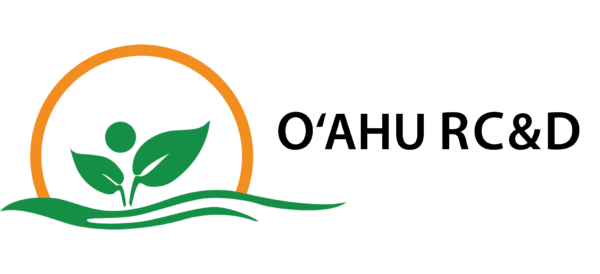Maui Soil Health Innovator
Lā Kāhea
Community Farm
Operation Background:
Elevation: 294 feet
Soil Series & Order: Waikapū Mollisol – This series consists of deep, well drained soils that formed in material weathered from old alluvium.
Operation: Dryland taro and turmeric
Winsome Williams, a passionate female farmer, founded Lā Kāhea Community Farm with Whitney Cunningham and Jakke Aoga to regenerate land and grow nutritious foods. Their farm is on a one acre regenerative demonstrative plot in Waikapū situated within Bobby Pahia’s larger agriculture operation, Hawaiʻi Taro (10 acres), on a 300 acre conservation easement. This area of Central Maui is hot, dry and windy; it usually receives around 13” of rain a year, most of which fell during the recent February 2023 storms.
For over 140 years, the land under Lā Kāhea Community Farm grew sugarcane and pineapple using conventional agriculture methods. Conventional practices seldom focus on adding carbon back into the system and often rely on synthetic fertilizers, herbicides and pesticides that reduce soil tilth and prevalence and diversity of biological life.
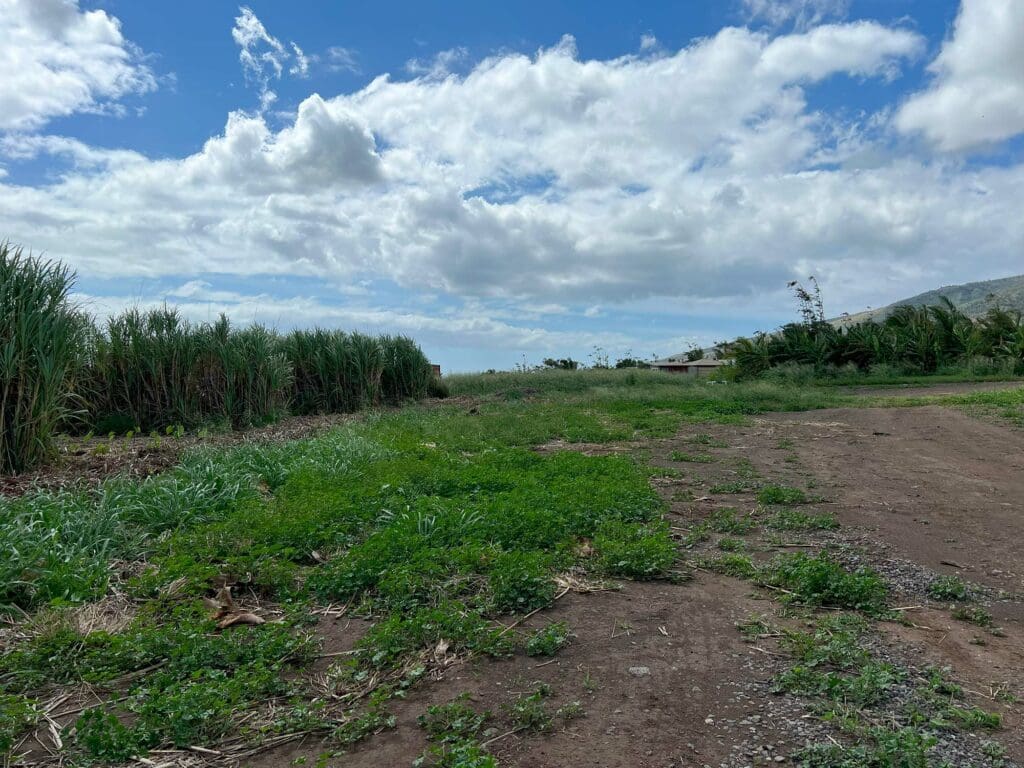
The degraded conditions, cost of inputs and in some cases, production limitations, from poor soil health belies the rich history of complex and highly productive systems of traditional Hawaiian agricultural practices, especially in colluvial areas like Waikapū. U.H. researchers recently developed models that indicate that historically, Kānaka Maoli farmers could have produced an amount of food using Native Hawaiian traditional farming practices that is comparable to the amount of food consumed annually in Hawaiʻi today on less land than what is currently farmed (albeit different foods than what we consume today). Their work shows the efficiency of indigenous agricultural systems, in line with other analyses indicating higher production per unit area using traditional farming practices compared with conventional agriculture1.
Inspired by the ingenuity of indigenous agroecosystems and their ability to feed communities, Winsome decided to experiment with planting kalo huli into very compacted, degraded soil using only high-quality compost as fertilizer. The kalo corms she produced were just as big as those grown using more costly fertilizers and other inputs and which required more water. That demonstration plot led Bobby Pahia to allow Winsome to expand her agriculture practices to a larger plot.
After continued success, Lā Kāhea Community Farm now uses the same techniques trialed in these early test plots for their full production fields. They also installed an agroforestry demonstration plot where they lead tours and introduce visitors to various tropical fruits like soursop, mulberry, ulu, finger limes, papaya, ti, noni, and groundcovers like pigeon pea and katuk, a nitrogen fixing leguminous tree and perennial cooking green, that can be used to increase soil fertility.
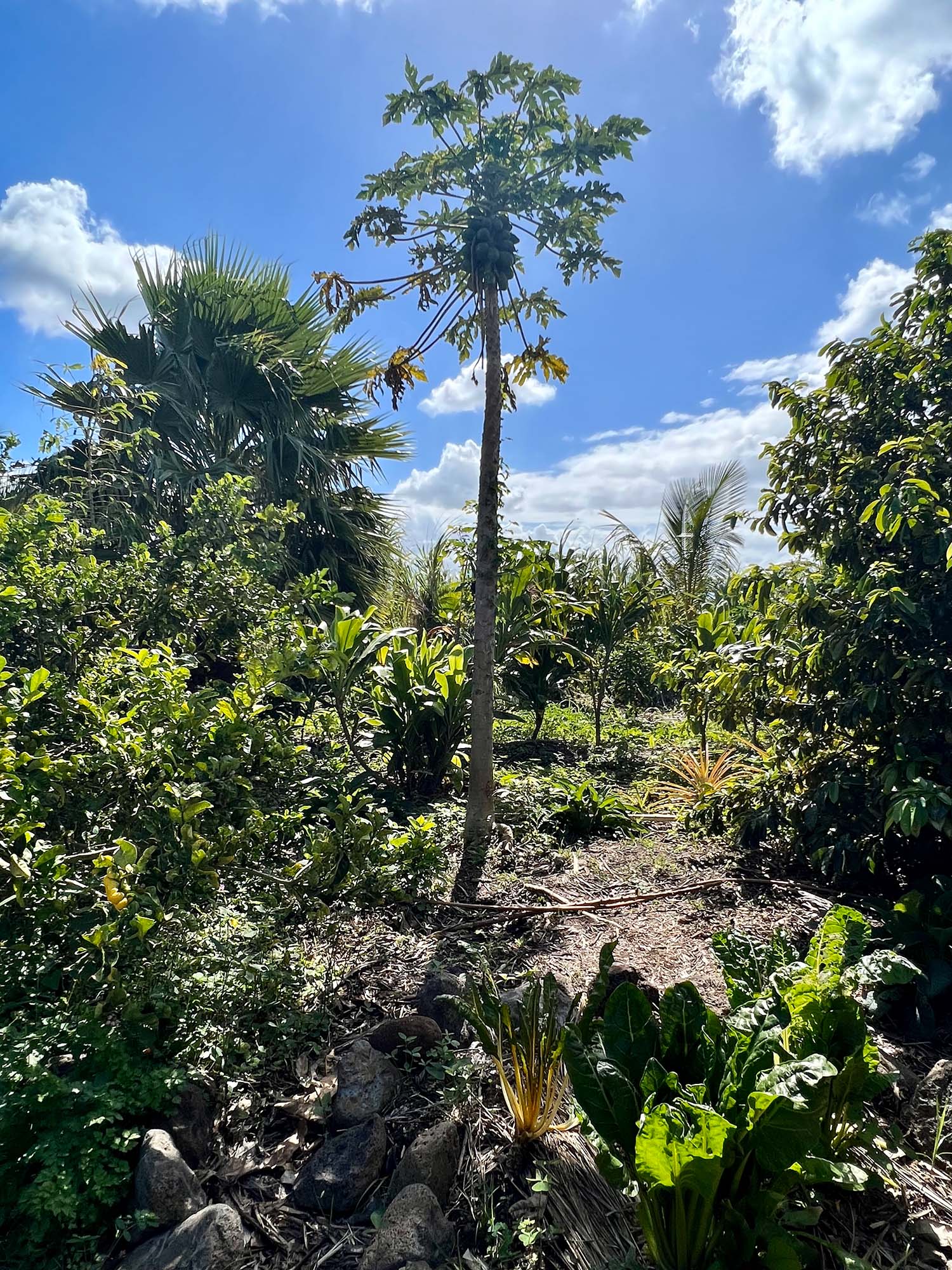
For Lā Kāhea Community Farm, their crop health, high yields and reduced cost of inputs have demonstrated the effectiveness of the soil health practices they use to manage high winds, moisture loss, compaction and overall soil tilth.
Current Soil Health Practices:
Soil Health Practice 1: Perimeter and In-Field Windbreaks
Lā Kāhea Community Farm uses diversified perimeter and in-field windbreaks around the edges of their farm to reduce impacts of the windy conditions. This practice creates a microclimate for their crops, reducing evapotranspiration and increasing soil moisture.
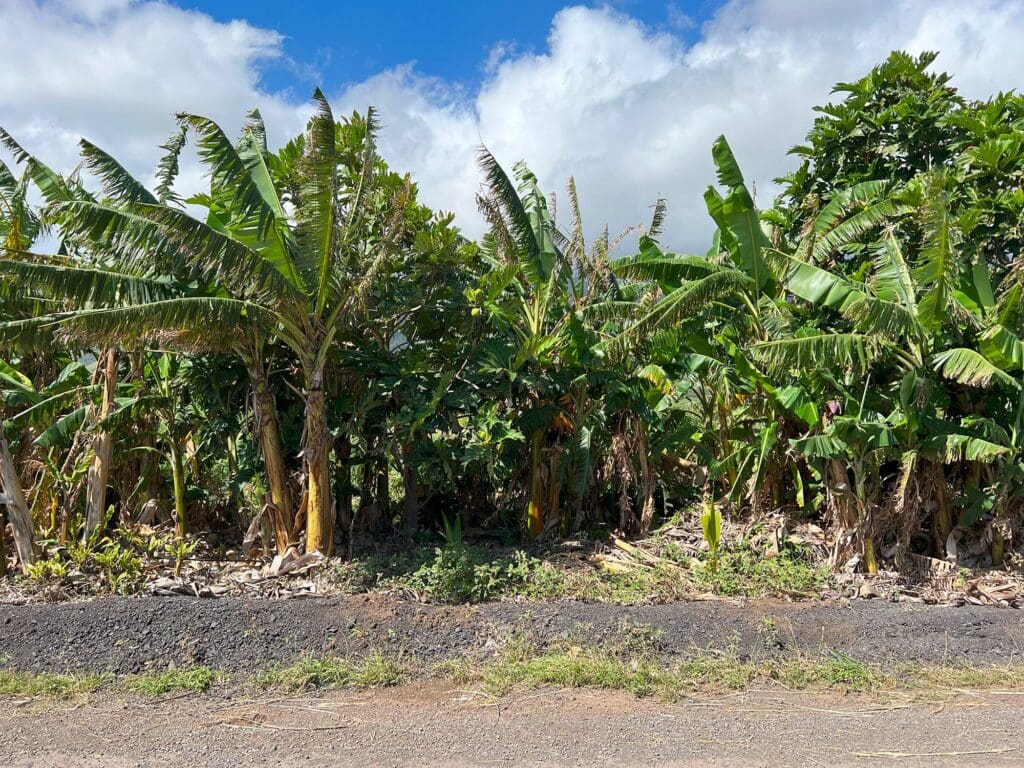
The farm uses sugarcane as their main in-field windbreak. Using this single species decreases the amount of labor hours that would be required to prune and maintain a windbreak with multiple species of trees and shrubs.
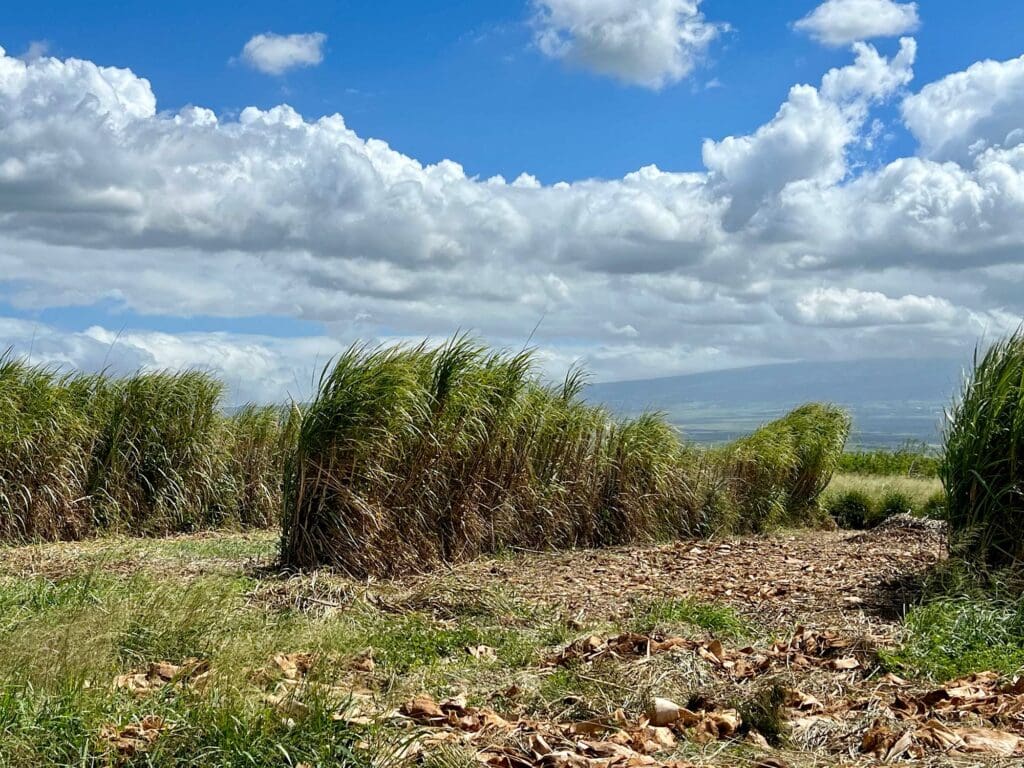
Soil Health Practice 2: Cover Cropping System
Sunn Hemp is seeded after harvesting their ‘olena and kalo crops and prior to each growing cycle as a source of starter nitrogen fertilizer. A lot of farmers grow Sunn Hemp and then till it into the soil and let it dry out which prevents the system from being able to provide nitrogen and moisture into the soil. At Lā Kāhea Community Farm, they terminate their Sunn Hemp using a roller crimper and then quickly cover the crop residue with a thick layer of mulch they receive from local tree trimmers. Using this termination method increases the amount of plant available nitrogen (PAN) the Sunn Hemp contributes to their nutrient management program and reduces the cost of nitrogen fertilizers.
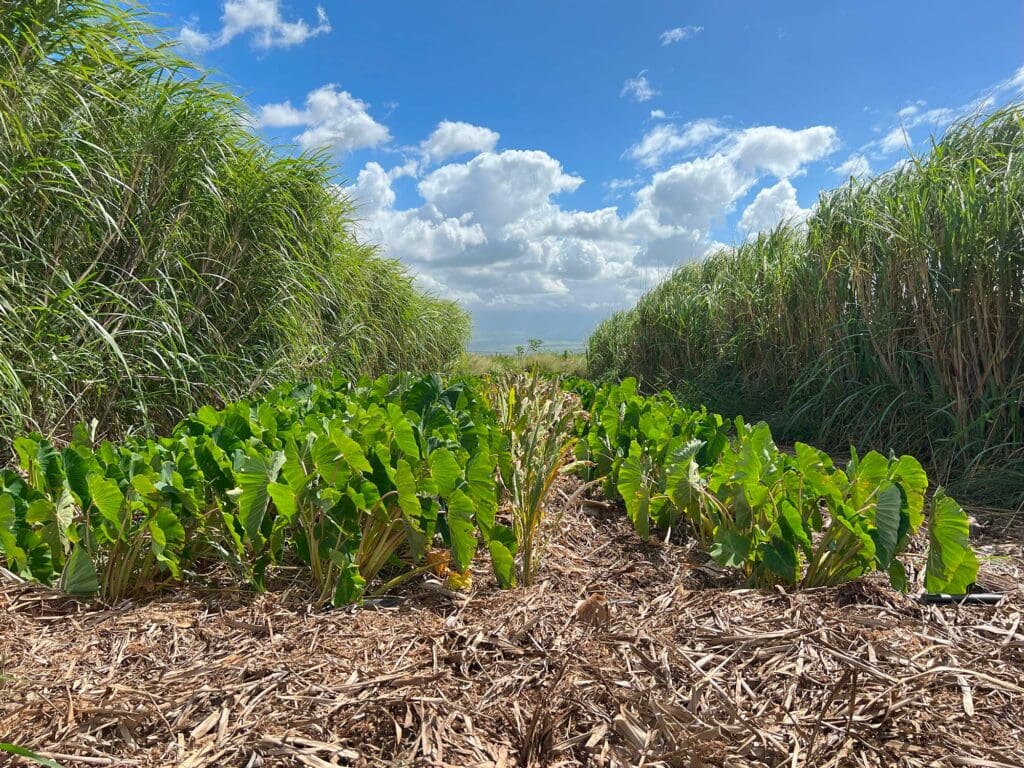
Yield and Break-Even
The proof that their cover cropping system works lies in the size of their corms and yield. During the 2022-2023 season, the farm produced around 3,500 lbs of kalo and 2,000 lbs of ‘olena (turmeric) on one acre. They estimate pigs ate over 2,000 lbs of cassava. Lā Kāhea Community Farm also creates a value-added product from the 4,000 lbs of banana they produce yearly. This is comparable size and yield to neighboring farms that rely on more costly fertilizer, herbicide and pesticide inputs.
For example, at Hawaii Taro, the larger farm within which La Kahea sits, Bobby Pahia does not use pre-plant fertilizer on his crops. He tills his field, plants kalo, covers the beds with mulch and adds OMRI listed Allganic 15-0-2 fertilizer once a week injected through his irrigation system. When the kalo corms begin to form around four months, he adds another Allganic fertilizer (0-0-52) until the plants are at the ideal size for harvest after around 7 months. Over the course of one growing season (9-10 mos), they spend approximately $566/ac for fertilizer amendments. They use approximately 77.4 lbs of Nitrogen per acre (~$482) and 38.2 lbs of Potassium per acre (~$84).
In general, the amount of fertilizer typically used to grow kalo differs based on varying site conditions and grower practice. UH researchers have estimated that taro can use 350 to 500 pounds of nitrogen per acre, depending on production goals, individual corm size envisioned and yields predicted2. These amounts are considerably higher than the 150 pounds per acre most other crops require.
Lā Kāhea Community Farm takes a different approach to adding fertilizers, instead focusing on broader soil health.
“As far as nitrogen is concerned, most people consider taro to be a “heavy nitrogen feeder.” However, we look at nutrient cycling a bit differently than most. With a healthy soil food web, (bacteria, fungi, protozoa, nematodes etc.) plants have the ability to uptake over 42 essential minerals and nutrients from the dirt, (aka the sand, silt & clay). So our focus is less on feeding plants nitrogen and more based around getting the proper microbes into the soil so that the plant can have access to and uptake all the nitrogen that is present in the dirt and that’s made available by surrounding nitrogen fixing plants.”
Winsome Williams
Using cover crops grown in mulch has helped Lā Kāhea Community Farm increase water holding capacity of their soil and decrease irrigation expenses. Kalo that once grew here under plastic mulch needed to be watered for eight hours a day, three times a week, whereas today the plants only require 3 – 4 hours of water a day, three times a week, or about half the amount of water for similar yield.
This means that from their cover crop practice, the farmers are saving anywhere between $25-$75 per week on irrigation costs (see sidebar for details).
Current water use calculation
Watering 3 hours per day, 3 times per week, for example using high flow T-tape drip irrigation ribbon with 8-inch emitter spacing at 10 pounds per square inch (psi), on 1 acre of kalo:
3 hours/day x 3 days/week = 9 hours/week
Flow rate of high flow T-tape drip irrigation ribbon with 8-inch emitter spacing at 10 pounds per square inch (psi) = .74 gallons/ minute/100 feet
There are 14,520 feet of row per acre when beds are spaced 36 inches center-to-center
To determine gallons/hour/acre emitted from one acre of drip irrigation ribbon, divide 14,520 (the number of row feet/acre) by 100 = 145 (the number of 100-foot lengths of drip irrigation ribbon in 1 acre).
Multiply 145 by .74 gallons/minute/100 feet (the amount of water delivered through each 100 feet of ribbon) = 107.4 gallons/minute/acre.
107.4 gallons/minute x 60 minutes = 6,446 gallons/hour/acre.
(calculations from Irrigation Principles and Practices Study Guide)
9 hours/week x 6,446 gal/hour/acre = 58,014 gal/week/acre
High cost estimate:
58,014 gal/1000 = 58.014 x $1.25 per thousand gallons = $72.52/acre/week
Low cost estimate: 58.014 x $0.42 per thousand gallons = $24.37/week
Past use water calculation: They used to use approximately double the amount of water:
High cost estimate: $72.52/acre/week x 2 = $145.04/week
Low cost estimate: $24.37/week x 2 = $48.74/week
| Kalo yield annually per acre | Estimated cost of nitrogen fertilizer per acre | Estimated cost of potassium fertilizer per acre | Estimated cost of irrigation | |
| Lā Kāhea Community Farm | ~ 3,500 lbs | $120* | N/A | $25-$75 acre/week |
| Hawaiʻi Taro | ~ 3,500 lbs | $482 | $84 | $50-150 acre/week |
The table above shows the cost-savings provided by LaKahea’s cover cropping practice. Cover crop provides a benefit by increasing the water and nutrient holding capacity of the soil, reducing the need for fertilizers and irrigation. These estimates show that La Kahea was able to yield the same amount of kalo with reduced input costs.
*This calculation was based on the purchasing price of sunn hemp seeds from Koolau Seeds for $3/lb and planting at a seeding rate of 60 lbs/ac (typical for small farm operations) for a total of $120 lbs per acre compared to the cost spent for applying 77.4# of urea nitrogen fertilizer per acre at ~ $482. This cost savings estimate on nitrogen fertilizer assumes that the cover crop of Sunn Hemp contributed adequate amounts of plant available nitrogen (PAN) based on field observation by the farmer of the annual yield and corm size. It does not take irrigation costs for sunn hemp into consideration.
Soil Health Practice 3: Compost Application
Lā Kāhea Community Farm partners with a neighboring operation, Seeking Root Farm, to get compost for their compost tea production. To decrease the labor cost of spreading dry compost in the field, Winsome uses compost tea to add carbon back into their production fields. Compost teas are a liquid form of carbon that can be readily used to support the growth of soil microbes and to make nutrients in the soil plant available.
The Seeking Root Farm makes their compost with food waste from restaurants, schools and hotels and landscaping trimmings, much of which they obtain for no cost and build into piles. The piles are built directly on existing soil protected by wind rows where they undergo a naturally occuring heating process. Then, they sift the compost using a compost screen which aerates the soil and reduces clumps to make a more uniform planting medium. After the compost is screened, they introduce worms into the sifted piles and let them help with the decomposition process for a few months until the finished, or cured, compost is ready.
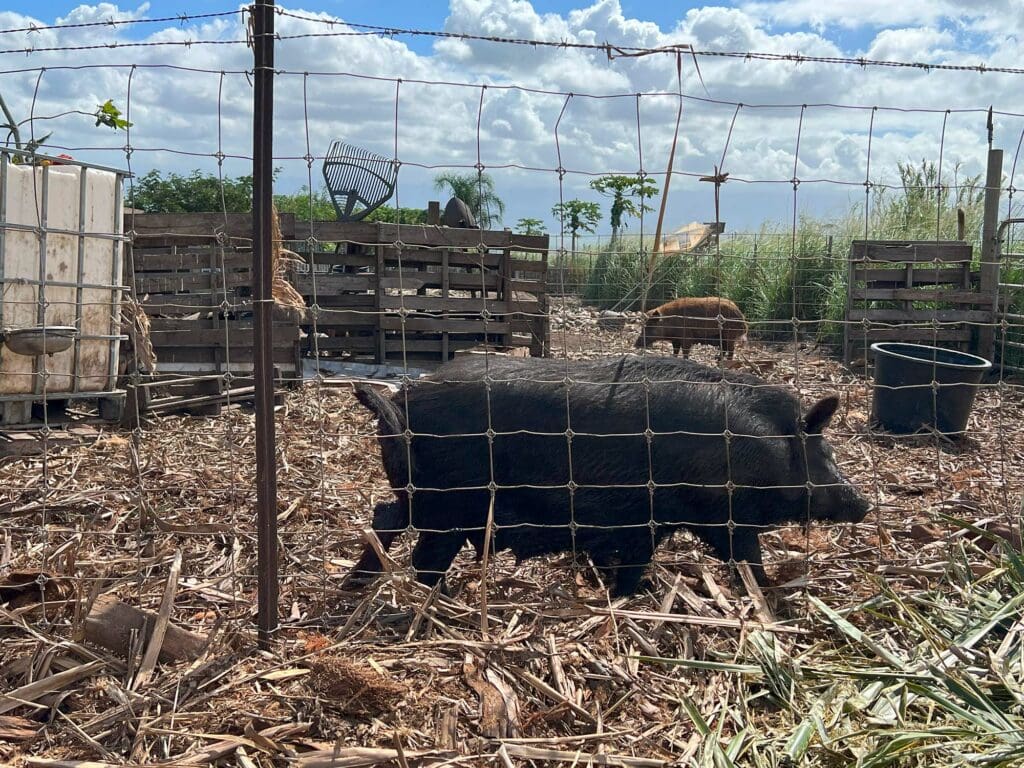
Compost Tea Recipe
Winsome uses 1-2 cups of BioComplete Compost to make a liquid extract from dry compost using a paint strainer bag and five gallons of non-chlorinated water. She puts the extract into a 100 gallon tank of non-chlorinated water with a little microbe food from Kiss Organics that contains dried fish meal, blood meal and bone meal. She does not agitate so as not to remove any beneficial microbes from the compost. The amount of time for brewing the compost tea depends on the desired bacterial to fungal ratio the plants need at a certain stage of growth. The microbes multiply and turn the 100 gallons of compost tea into a concentrate. The tea is diluted to a 1:10 ratio and applied to the cash crop.
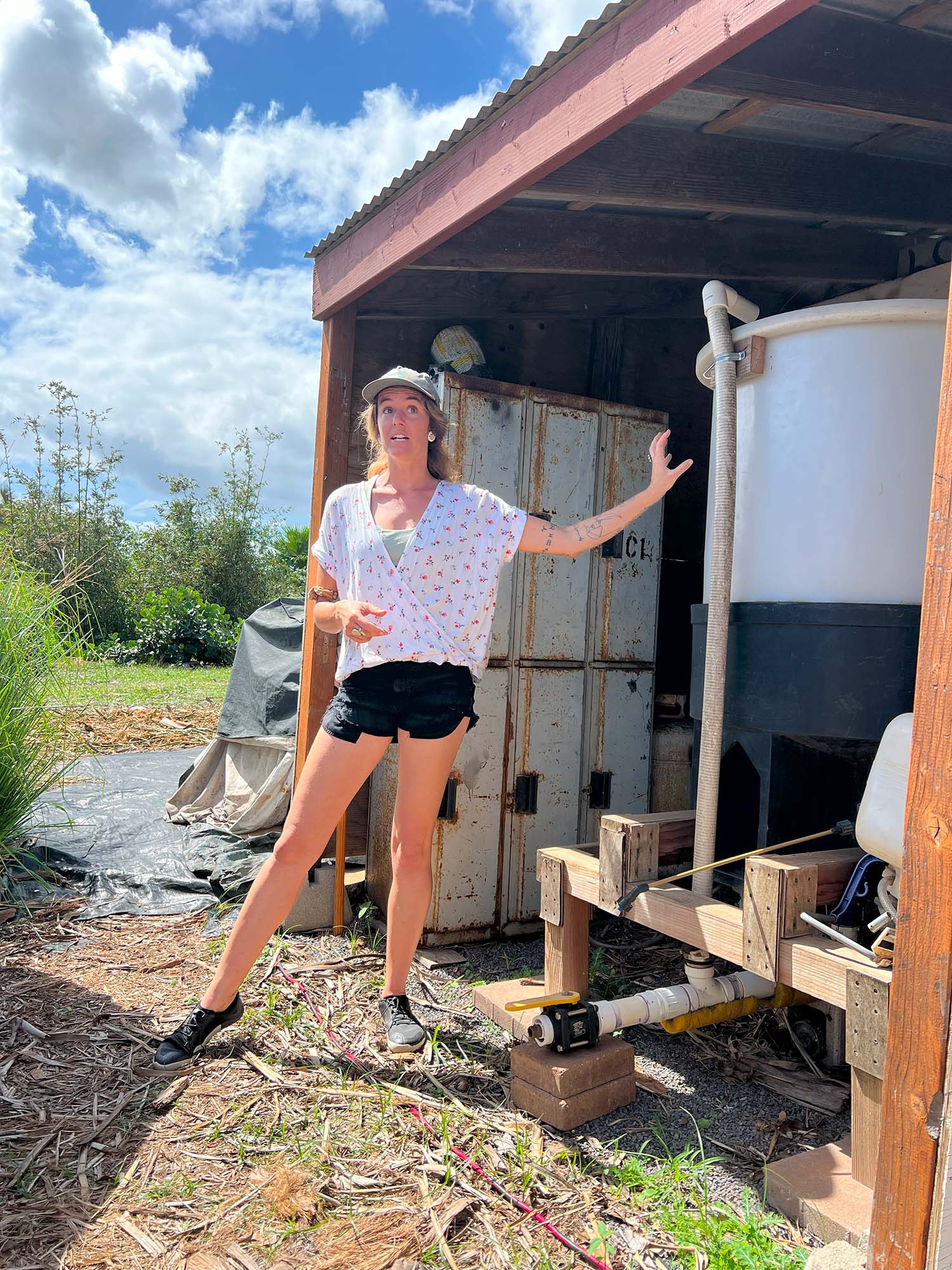
Many farmers overlook the importance of adding different types of carbon to the system. Besides adding liquid carbon to their cash crop by fertigating with compost tea, Lā Kāhea Community Farm also adds more “deep carbon” into their system, or carbon that will remain in the soil and release over a longer time period, by planting a diversity of cash and cover crops with diverse root systems. Their Sunn Hemp rotations add carbon and large amounts of organic matter. There are many different sources of carbon farmers can choose from (since carbon is generated from animal products and plant material). These soil health practices at Lā Kāhea Community Farm are simple, cost effective and provide a diversity of carbon sources to feed their system.
Soil Health Practice 4: Designated Accessways
Pathways around the farm are designed to reduce compaction and weed pressure through layers of cardboard and heavy mulch which helps retain moisture and lower soil temperatures. The mulch includes coconut palm fronds and other landscaping waste from nearby hotels.
Past Soil Health Practices:
Lā Kāhea Community Farm has tried making large batches of Korean Natural Farming (KNF) soil amendments and foliar sprays. However, this was very labor intensive and not practical for their operation—which is constrained to the hard working efforts of three humans who help with daily hand watering. If they had other machinery and equipment to make watering more efficient, they would continue using KNF. Ideally, the setup would include a tank to hold compost tea or KNF that sat on the back of their ATV with an extension hose with a spray nozzle specifically designed to emit microbes. The microbes are sensitive and don’t like getting smashed and stuck into sharp corners, so there are specific nozzle heads and rounded tank designs that optimize the use of these kinds of foliar sprays. Lā Kāhea Community Farm also had a large vermicast system that they weren’t able to keep up with since they don’t live on the farm and are not able to have the system closely managed.
NRCS was offering to pay farmers $1000/ac to lay down black plastic sheeting for weed control. Since Lā Kāhea Community Farm relies on heavy mulch applications for weed control instead of black plastic, which farmers often just till back into the land, Winsome petitioned the NRCS local field office to also pay the same rate for other weed suppression approaches, such as using locally sourced wood chips. Lā Kāhea Community Farm received a $3000 grant from NRCS for mulching and now other farmers sharing adjacent plots also receive NRCS funding for using biodegradable weed controls which also helps with water retention and reduced evapotranspiration.
Other Lessons Learned
Like many farmers, the cooperators at Lā Kāhea Community Farm continuously learn and adapt their soil health practices. Recently, they’ve observed aphid issues and rose beetle damage on kalo leaves. Winsome thinks this increase in pest pressure is due to their practice of adding mulch following the termination of their cover crop. They plan to adapt this practice by using a thinner layer of mulch, which will allow adequate air circulation in the system. It may also be that the mulch they applied wasn’t too thick, but was an unanticipated outcome from the pigs who uprooted their cassava plants and that the mulch from the cassava ended up on top of the kalo mulch.
- Natalie Kurashima, Lucus Fortini, Tamara Ticktin. (2019) The potential of indigenous agricultural food production under climate change in Hawaiʻi. Nature Sustainability VOL 2. (March 2019) 191-199. https://www.nature.com/articles/
- Glenn Teves. (2015) Growing Upland Taro. Molokai Native Hawaiian Beginning Farmer Quarterly. (July – September) 1-14. Growing Upland Taro
Note: As part of Oʻahu Resource Conservation and Development Council’s Soil Health Training Cohort, we are proud to feature some of the innovative practices local farmers are using to regenerate and restore soil health and on-farm ecological services. To learn more about this initiative, please visit our website.
This material is based upon work supported by the U.S. Department of Agriculture, under agreement number NR2192510002C002. Any opinions, findings, conclusions, or recommendations expressed in this publication are those of the author(s) and do not necessarily reflect the views of the U.S. Department of Agriculture. In addition, any reference to specific brands or types of products or services does not constitute or imply an endorsement by the U.S. Department of Agriculture for those products or services.
Resources and References:
- Growing Upland Taro
CTAHR extension published a guide on growing upland taro which includes tips for huli and leaf production, soil preparation and nutrient management, weed and pest management, and more. - Indigenous Agricultural Food Production
This study used spatial distribution models of indigenous Hawaiian agroecosystems to examine their past and future production potential under varying climate and land use scenarios. Results suggest they have high production levels, comparable to those of today, even under land use and climate changes. Authors recommend the restoration of these systems into the future. - How to Cultivate Indigenous Microorganisms
CTAHR publication on how to collect, culture, and apply indigenous microorganisms as a biological amendment to your crop production systems. - The Development of Indigenous Microorganisms Using Korean Natural Farming Methods
This CTAHR publication outlines the culturing and nurturing of indigenous microorganisms (IMO) necessary for successful Korean Natural Farming methods, as well as quantifies associated costs of the practice. - Promoting Plant Growth with Compost Tea
Article summarizing UH Manoa research funded by Western SARE on compost tea in Hawaii. Provides an overview of compost tea as well as recommendations for growers including what materials to use to ensure high quality applications, how to apply and what effects to reasonably expect. - Designing in-field and perimeter windbreak systems
An online lesson hosted by Oahu RC&D with a host of resources to help you design an effective windbreak. Includes guides and decision making support tools to aid in choosing a design and species that support your soil health and overall farm management goals.

